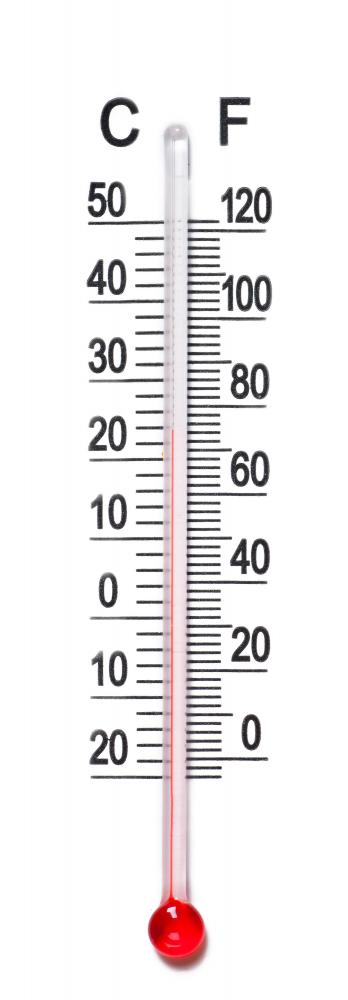What is the History of the Fahrenheit Scale?
The Fahrenheit scale, which measures temperature, was created by Daniel Gabriel Fahrenheit (1686-1736), a German-Dutch scientist, in 1724. He devoted much of his life’s work to the measurement of temperature, and also invented the alcohol and mercury thermometers. On the Fahrenheit scale, the point at which frozen water melts is 32°, and the point where at which it boils is 212°. Between these two points is exactly 180°, a number easily divisible on a thermostat. Although we know with a degree of certainty what measurements the scientist used to determine his scale, his process of arriving at the final scale is largely unknown.
Several stories have circulated regarding how Fahrenheit devised his scale. One is that he established 0° as the coldest temperature he could measure outdoors during the winter of 1708 to 1709 in Danzig (Gdańsk), Poland. This measurement and his own body temperature, which he measured at 100°, were the two marks on which he based the rest of his scale. Many think that either his thermometer was off or he was running a fever that day, resulting in the relatively high reading on the bodily temperature. The scale was then divided into 12 separate segments, which were later divided into eight, creating a scale of 96 separate degrees.

In another story, Fahrenheit figured 0° by taking a measurement of the point at which equal parts of salt and ice mixed together melt. He then established 96° as the blood’s temperature. Yet another story holds that he co-opted Ole Rømer’s scale of temperature. With this scale, 7.5° is the freezing point of water. Fahrenheit multiplied this number to get rid of the fractions, and then refigured 32° as water’s freezing point, with 64 degrees separating the body’s temperature at 96°. He then marked degrees using six lines.

Some believe that Fahrenheit was a Freemason, and because there are 32 degrees of enlightenment, he chose to use 32 as the melting temperature of water. Degrees are also used as levels with the Freemasons, hence the use of the word on the scale. However, there is no documented evidence that the scientist was a Freemason.
In yet another story, it is said that Fahrenheit believed that a person would freeze to death at 0° and would die of heat stroke at 100°. This created a scale of 0° to 100° that encompassed the range of livable temperatures. Another story states that he recorded the melting point of water, the boiling point and a human’s body temperature, and then put the melting and boiling points exactly 180 degrees apart. One far fetched story says that Fahrenheit observed the melting point of butter as 100° and set it accordingly.

Because Fahrenheit degrees are 5/9 of a Celsius degree, it is easier to make more exact measurements without using fractions in the Fahrenheit scale. This scale continues to be used in the United States, although most other countries that use the metric system changed to Celsius in the 1960s and 1970s.
AS FEATURED ON:
AS FEATURED ON:















Discussion Comments
I think the Fahrenheit scale gets quite a bit of hate it doesn't deserve. Its big drawback is that the points special to humans (0, 100) are not well placed. I really don't see why any set of zero points is inherently better than any other. One great advantage of Fahrenheit is that there is less of a need for fractions or decimals. I'm not sure there's any reason why any rate of temperature change between degrees is better.
Another advantage of Fahrenheit is a social one. When using the Fahrenheit scale, if you say "it's below freezing" that means it's cold. But if you say "it's in the negatives" that means it's really, really cold. Ultimately, though, I'll use either scale as long as I can tell what winter clothes I need.
Personally, the celsius scale makes so much more sense to me. Water freezing at 0, boiling at 100; it just seems so orderly. Then again, I've never really had the chance to witness the other side (i.e. Fahrenheit) because I live in a country that had adopted the metric system. I just don't really understand how the Fahrenheit system works. It's just so -- what's the word -- kind of disorganized. I'm a bit OCD with this type of thing, though.
I'm just glad I don't have to deal with temperature in my life all that much since I am still a student and am not intending to get a job that has anything to do with temperature. One less thing for me to worry about.
Considering humans are the only species on the planet to have developed a counting system, the fact that they based their counting system on their "accidentally" evolved ten upper digits seems perfectly natural. I would agree, however, that any counting system is relatively arbitrary, as counting is just an abstraction anyway.
There is nothing "natural" about "the counting number of ten,” other than that it is an accident, an artifact of our having evolved ten fingers. The metric system is similarly flawed, and praise of it is entirely misguided. Instead of converting all of our measurement systems to decimal, we should have converted our counting system to base twelve. Then, at least, we would have clean divisions of three and four, much more practical in the real world, where most of us live.
There are some strange and quirky systems of measurement that we hold on to in the US while the rest of the world adopts the metric system. It is just so much more efficient to use a system based on the natural counting number of ten. What would Fibonacci say if he could see how little we've advanced in terms of adaptability in measurement since his day?
Trying to convert celsius to fahrenheit is one of the biggest difficulties I have had while in Europe. the first few times I walked outside this fall to see thermometers reading that it was 2 degrees were strange indeed. At the same time, I don't know that I think either system is any better than the other; it's just one of those things based on where you live and what you learn first.
Post your comments